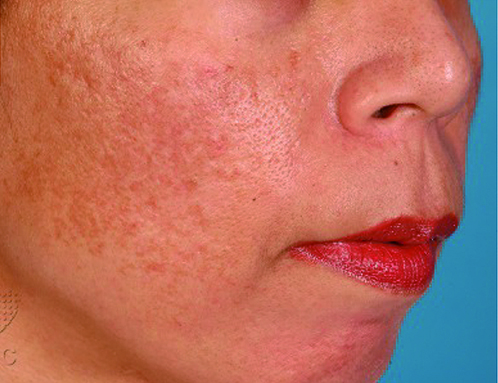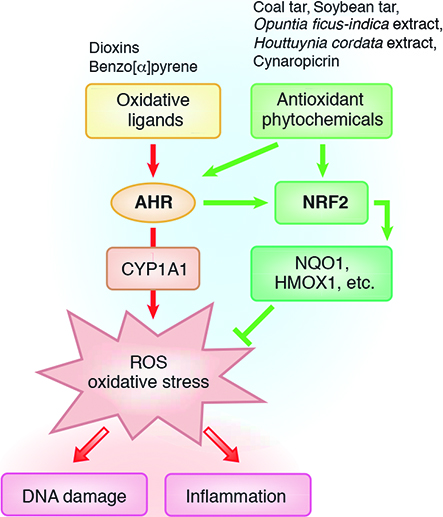Content - Volume 98, Issue 10
You can find all new content after October 1 on our new website, you can find it
here.
Editor's choice in this issue
REVIEW
Sulekha Kumari, Steven Tien Guan Thng, Navin Kumar Verma, Hemant K. Gautam

Melanogenesis or excessive production of melanin in the skin causes hyperpigmentation disorders - melasma, senile lentigines and freckles. Although skin hyperpigmentation is not a serious health concern, it can profoundly impact individual’s appearance and cause cosmetic disfigurement. Here, we summarize the molecular mechanism of melanogenesis and update about inhibitors currently being applied or investigated to manage hyperpigmentation.
Pages: 924-931
REVIEW
Masutaka Furue, Akiko Hashimoto-Hachiya, Gaku Tsuji

Aryl hydrocarbon receptor (AHR) is a chemical sensor that is expressed abundantly in epidermal keratinocytes. Oxidative AHR ligands induce the production of reactive oxygen species. However, antioxidant AHR ligands inhibit reactive oxygen species generation via activation of nuclear factor-erythroid 2-related factor-2, which is a master switch for antioxidative signalling. In addition, AHR signall ...
Pages: 918-923
All articles
REVIEW
Masutaka Furue, Akiko Hashimoto-Hachiya, Gaku Tsuji
Aryl hydrocarbon receptor (AHR) is a chemical sensor that is expressed abundantly in epidermal keratinocytes. Oxidative AHR ligands induce the production of reactive oxygen species. However, antioxidant AHR ligands inhibit reactive oxygen species generation via activation of nuclear factor-erythroid 2-related factor-2, which is a master switch for antioxidative signalling. In addition, AHR signall ...
Pages: 918-923
REVIEW
Sulekha Kumari, Steven Tien Guan Thng, Navin Kumar Verma, Hemant K. Gautam
Abnormally high production of melanin or melanogenesis in skin melanocytes results in hyperpigmentation disorders, such as melasma, senile lentigines or freckles. These hyperpigmentary skin disorders can significantly impact an individual’s appearance, and may cause emotional and psychological distress and reduced quality of life. A large number of melanogenesis inhibitors have been developed, b ...
Pages: 924-931
CLINICAL REPORT
Alexandra B. Kimball, Thrasivoulos Tzellos, Brian M. Calimlim, Henrique D. Teixeira, Ziqian Geng, Martin M. Okun
Hidradenitis Suppurativa Clinical Response (HiSCR), is a validated tool that has been used to assess the efficacy of adalimumab among patients with hidradenitis suppurativa. We evaluated the clinical meaning of HiSCR by relating it to patient-reported outcomes to give further context to its achievement in a post hoc analysis of integrated data from two phase 3 clinical trials (PIONEER I and II). P ...
Pages: 932-937
CLINICAL REPORT
Liv Kroona, Marléne Isaksson, Camilla Ahlgren, Jakob Dahlin, Magnus Bruze, Gunnar Warfvinge
Carvone (l-carvone), a mint flavour in spearmint oil, is considered a mild skin sensitizer. Carvone-sensitization may be linked to oral/perioral signs and oral lichen planus, but studies are sparse. The prevalence of patch test reactions to carvone and relevant findings from the positive group were investigated. Records for patch-tested patients at the Malmö clinic, for the period 1996 to 2016, w ...
Pages: 938-942
CLINICAL REPORT
Danielle J.P. Bartels, Antoinette I.M. van Laarhoven, Peter C.M. van de Kerkhof, Andrea W.M. Evers
Nocebo effects, i.e. reduced treatment effects due to patients’ negative expectations, play a role in itch. Recent studies have shown that nocebo effects can be induced experimentally on itch and also be minimized and even turned into the opposite direction, i.e. placebo effects. It is not known whether these effects generalize to itch-associated scratching behaviour. The aim of this study was t ...
Pages: 943-950
CLINICAL REPORT
Iris Amitay-Laish, Hadas Prag-Naveh, Adam Dalal, Lev Pavlovsky, Meora Feinmesser, Emmilia Hodak
Data on the treatment of early folliculotropic mycosis fungoides, a recently defined clinicopathological subgroup of folliculotropic mycosis fungoides with an indolent course, is limited. Treatment outcomes were studied in a retrospective cohort of 47 adults with early folliculotropic mycosis fungoides, with a focus on psoralen plus ultraviolet A (PUVA) monotherapy, including dosimetric data, and ...
Pages: 951-955
CLINICAL REPORT
Verena G. Frings, Kristina Röding, Alexander Strate, Andreas Rosenwald, Sabine Roth, Hermann Kneitz, Matthias Goebeler, Eva Geissinger, Marion Wobser
Primary cutaneous marginal zone lymphomas (PCMZL) frequently exhibit lymphoplasmacytoid/plasmacytic differentiation, implying the capacity to produce monoclonal immunoglobulins. As these paraproteins are secreted, and thus are measurable in blood and urine, they may correlate with disease burden and serve as tumour markers reflecting therapeutic response. This study retrospectively analysed the re ...
Pages: 956-962
CLINICAL REPORT
Gonzalo Segurado-Miravalles, Natalia Jiménez-Gómez, Oscar Muñoz Moreno-Arrones, Ivette Alarcón-Salazar, Adrian Alegre-Sánchez, David Saceda-Corralo, Pedro Jaén-Olasolo, Salvador González-Rodríguez
Treatment of actinic keratosis with 3% diclofenac sodium w/w in hyaluronic acid is associated with a concomitant improvement in signs of photodamaged skin. However this effect has not yet been examined in depth. Twenty patients with actinic keratosis and signs of photodamaged skin were studied. They received treatment with diclofenac sodium w/w in hyaluronic acid for 2 months. Clinical and reflect ...
Pages: 963-969
CLINICAL REPORT
Isabel Rodríguez-Blanco, Ángeles Flórez, Carmen Paredes-Suárez, Romina Rodríguez-Lojo, Daniel González-Vilas, Aquilina Ramírez-Santos, Sabela Paradela, Ignacio Suárez Conde, Manuel Pereiro-Ferreirós
Actinic cheilitis is thought to be a premalignant lesion or a superficial squamous cell carcinoma. The prevalence of actinic cheilitis in Europe is unknown. The aim of this study was to determine the prevalence of actinic cheilitis in the Galicia region (north-west Spain). Secondary objectives were the description of risk factors of actinic cheilitis. A cross-sectional multicentre study in patient ...
Pages: 970-974
SHORT COMMUNICATION
Maria Cho, Tetsuya Honda, Chiyuki Ueshima, Tatsuki Kataoka, Atsushi Otsuka, Kenji Kabashima
Abstract is missing (Short commuication)
Pages: 975-976
SHORT COMMUNICATION
Grigorios Theodosiou, Åke Svensson
Abstract is missing (Short Communication)
Pages: 977-978
SHORT COMMUNICATION
Igor Snast, Einav Bercovici, Tomer Avni, Dorit Shitenberg, Emmilia Hodak, Lev Pavlovsky
Abstract is missing (Short communication)
Pages: 979-980
SHORT COMMUNICATION
Hao Chen, Yan-ning Xue, Chong-mei Xin, Jing-shu Xiong, Xiao Ni, Jian-Fang Sun
Abstract is missing (Short communication)
Pages: 981-982
SHORT COMMUNICATION
Hiroyuki Takama, Makiko Yoshida, Kentaro Izumi, Takeshi Yanagishita, Jun Muto, Yuichiro Ohshima, Wataru Nishie, Hiroshi Shimizu, Masashi Akiyama, Daisuke Watanabe
Abstract is missing (Short communication)
Pages: 983-984
SHORT COMMUNICATION
Valerio Gaetano Vellone, Emanuele Cozzani, Leonardo Peñuela, Roberto Russo, Bruno Spina, Carlo Toncini, Carlo Terrone, Aurora Parodi
Abstract is missing (Short Communication)
Pages: 985-986
SHORT COMMUNICATION
Tomohiro Oiwa, Teruasa Murata, Tetsuya Honda, Satoshi Nakano, Kenji Kabashima
Abstract is missing (Short communication)
Pages: 987-988
SHORT COMMUNICATION
Yanqing Chen, Haiqin Jiang, Wenyue Zhang, Zhiming Chen, Youming Mei, Hao Chen, Ying Shi, Wei Gao, Le Wang, Santosh Chokkakula, Hongsheng Wang
Abstract is missing (Short communication)
Pages: 989-990
SHORT COMMUNICATION
Peter K.C. Goon, Puran Gurung, Nick J. Levell, Priya Subramanian, Adrian S.W. Yong, Kevin Y.C. Lee, Laszlo Igali, David Greenberg, Syed N. Shah, Eunice K.H. Tan
Abstract is missing (Short communication)
Pages: 991-992
QUIZ
Ayano Ikeda, Hiroyuki Goto, Kazunari Sugita, Osamu Yamamoto
Abstract is missing (Quiz)
Pages: 993-994

